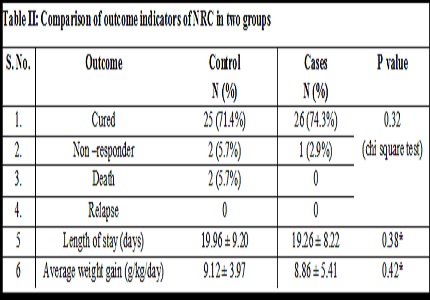Effect of vitamin D supplementation in children with severe acute malnutrition in a nutritional rehabilitation centre: a randomized controlled trial
Abstract
Background: According to World Health Organization (2013) approximately 35% of the under-fivemortalities are due to nutrition related factors & 4.4% of deaths are due to severe wasting. It has been found that Vitamin D levels are low in children with malnourished and very sick children. Even the prevalence of vitamin D deficiency is very high in Indian subcontinent. In WHO recommendations for the management of severe acute malnutrition there is no role of vitamin D supplementation.
Objective: To study the effect of vitamin D supplementation on severe acute malnourished children admitted in nutritional rehabilitation Centre.
Design: Single blinded Randomized controlled, parallel group trial.
Setting: Nutritional Rehabilitation Centre (NRC) of a tertiary care hospital.
Participants: 70 severe acute malnourished children aged 6 months to 59 months admitted in the NRC were randomized by computer generated random table. Intervention: 6 lakhs IU vitamin D was given intramuscularly on day one of therapy after an informed consent to the study group and other group was given only management of SAM. Main Outcome measure: outcome indicators of NRC i.e. cure rate, death rate, non-responders, relapse rate.
Results: There was no significant difference in the outcome indicators of NRC i.e cured, death, non-response and relapse rate (p=0.32) and average weight gain (p= 0.38) and length of stay (p=0.42) between the two groups at discharge but wasting (p=0.02 on first, p=0.008 on third and p=0.04 on fourth follow ups respectively) improved significantly on follow ups.
Conclusions: vitamin D supplementation does not have any significant improvement in the outcome indicators at discharge but significantly improves wasting on follow up.
Downloads
References
2. Holick MF. Vitamin D deficiency. N Engl J Med. 2007 Jul 19;357(3):266-81. [PubMed]
3. Harinarayan CV, Joshi SR. Vitamin D status in India--its implications and remedial measures. J Assoc Physicians India. 2009 Jan;57:40-8. [PubMed]
4. Ponnaarmeni S, Angurana SK, Singhi S, Bansal A, Dayal D et al.Vitamin D Deficiency in critically ill children with sepsis. Pediatrics and international child health.2016;36:15-211. [PubMed]
5. Hebbar KB, Wittkamp M, AlvarezJA, Mccracken CE, Tangpricha V. Vitamin D deficiency in pediatric critical illness. Journal of clinical and translational endocrinology. 2014;1(4):170-175. Available from URL: htt://www.science direct.com/science/article/pill/S2214623714000345. Accessed on 15/3/2017.
6. Shah SK, Kabra SK, Gupta N, Pai G, Lodha R.Vitamin D Deficiency and Parathyroid Response in Critically-illChildren: Association with IllnessSeverity and ClinicalOutcomes.Indian Pediatr. 2016 Jun 8;53(6):479-84.
7. WHO. Guideline: Updates on the management of severe acute malnutrition in Infants and children. Geneva, World Health Organization 2013; 31. Available from URL: http://www.who.int/nutrition/publications/ guidelines / updates_ management_SAM_infantandchildren/en/). Accessed on 12/8z/2016
8. Operational Guidelines on Facility based Management of children with Severe Acute Malnutrition, Ministry of Health and Family Welfare, Government of India, 2011. Available from: http://www.nihf.org/NCHRC-Publications/ Operational Guidelines. Accessed November 15, 2015.
9. Ejaz MS, Latif N.Stunting and micronutrientdeficiencies in malnourishedchildren. J Pak Med Assoc. 2010 Jul;60(7):543-7.
10. WHO guidelines: updates on the management of severe acute malnutrition in infants and children. Geneva: World Health Organization.2013. Available from URL: apps.who.int>iris978941506328_eng. Assessed on 27/11/2017.
11. Nabeta HW, Kasolo J, Kiggundu RK, Kiragga AN, Kiguli S.Serumvitamin Dstatus in children with protein-energy malnutritionadmitted to a nationalreferralhospital in Uganda. BMC Res Notes.2015Sep7;8:418. doi: 10.1186/s13104-015-1395-2. [PubMed]
12. Das RR, Singh M, Naik SS. Vitamin D supplementation for treatment of acute childhood pneumonia: A systemic review. ISRN Pediatr. 2013. [PubMed]
13. Madden K, Feldman HA, Smith EM, Gordon CM, Keisling SM, Sullivan RM, Hollis BW, Agan AA, Randolph AG. Vitamin D deficiency in critically ill children. Pediatrics. 2012 Sep;130(3):421-8. doi: 10.1542/peds.2011-3328. Epub 2012 Aug 6. [PubMed]
14. Walker SP, Golden MH. Growth in length of children recovering from severe malnutrition. Eur J Clin Nutr. 1988 May;42(5):395-404. [PubMed]
15. Richard SA, Black RE, Checkley W. Revisiting the relationship of weight and height in early childhood. Adv Nutr. 2012 Mar 1;3(2):250-4. doi: 10.3945/an.111.001099.
16. Richard SA, Black RE, Gilman RH, Guerrant RL, Kang G et al. Wasting is associated with stunting in early childhood. J Nutr. 2012Jul;124(7): 1291-6. [PubMed]

Copyright (c) 2018 Author (s). Published by Siddharth Health Research and Social Welfare Society

This work is licensed under a Creative Commons Attribution 4.0 International License.


 OAI - Open Archives Initiative
OAI - Open Archives Initiative


